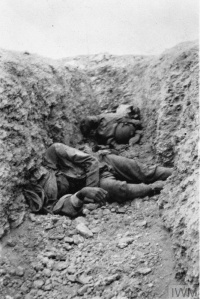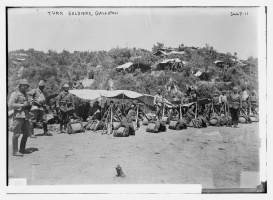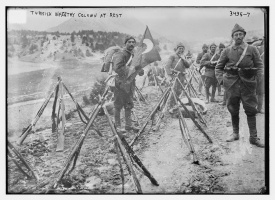Introduction↑
Underrated by both its allies and enemies, the Ottoman army tenaciously remained on the battlefield throughout the four years of the Great War. Although the Ottomans ultimately met defeat, they performed surprisingly well, with notable victories at the Dardanelles in 1915 and Kut al Amara (Mesopotamia) in 1916. Ottoman troops battled across a vast geography, despite tremendous challenges. Quite remarkably, the Ottoman war machine supplied enough men for combat on four major fronts (the Dardanelles, the Caucasus, Sinai-Palestine, and Mesopotamia-Iraq) and on less intensive ones (Arabia-Yemen, Romania, Galicia, Macedonia, Iran, and Azerbaijan). Out of its total population of around 22-23 million, the Empire mobilized around 2,900,000 men. This ratio (total men mobilized / total population) amounts to approximately 13 percent, which compares favorably to major European powers. The same ratio was 15.1 in Austria-Hungary, 15.6 in Italy, and 19.8 in Germany. Indeed, compared to the failure of Ottoman mobilization during the Balkan Wars (1912-1913), the Ottoman experience in the Great War might even be considered a “success” story.[1]
However, Ottoman mobilization during the Great War suffered major problems. Chief among them was desertion. While the Ottoman troops did not mount large-scale mutinies like those in 1917 France, they deserted in great numbers. This was a major cause of the decline in Ottoman war performance. Desertion also became a major social problem, prompting civilian and military measures that furthered state penetration of society.
The first part of this article provides a short panorama of Ottoman mobilization in the Great War and resistance to it, the ultimate form of which was desertion. It presents an overview of desertion, with a specific focus on the Muslim population of Anatolia. It uses Ottoman state documents to explore how military authorities explained the problem. Records reveal that desertions became a major military and social concern in the Ottoman Empire. Finally, the article explores how deserters survived. Many chose to hide near their own villages and received shelter from fellow villagers. Others resorted to brigandage by forming armed bands. Generally formed along ethnic and religious lines, the proliferation of these bands of deserters-turned-brigands, along with other deserters who did not turn brigand but still roamed the countryside, constituted a threat to state authority. The article argues that the act of desertion can be seen as a form of resistance by the ordinary enlisted man to an imposed duty under unbearable and no-longer justifiable conditions.
Understanding Desertion in the Ottoman Army↑
The Extent of the Problem↑
The existing statistical data on Ottoman desertions that can be accessed in the archives either provide us with round total numbers at a very general level, or with fragmentary statistics for specific regions during specific periods. Significant mid-level data such as the precise and cumulative numbers of desertions for each year of the war, for each major front throughout the war, or for different ethnic-religious groups are lacking. Yet, the available statistics suffice to show the remarkable extent and seriousness of desertion for the Ottoman war experience.
The official casualty statistics of the Great War, issued by Ottoman authorities just after the war, do not provide a specific set of data for desertions. They included desertions under a more general heading of “deserters, POWs, sick, missing,” the total number of which is 1,565,000. This remarkably high number amounts to almost 70 percent of the total number of all casualties, which is 2,290,000.[2] From various relevant sources, both primary and secondary, we are able to estimate that the aggregate number of deserters amounted to more than 500,000 by the summer of 1918. Given the total number of enlisted men in the Ottoman military throughout the war, which was around 2,900,000, the total number of deserters amounts to almost one-sixth, or approximately 17 percent of all men enlisted during the war.[3]
Various significant specific sources confirm the gravity of the problem. For example, the German consul in Erzurum reported in a telegram on 2 June 1915 that one-third of the troops gathered in the camps of the Third Army in Eastern Anatolia had fallen sick and that “another one-third had deserted on the march to the army.”[4] On the Caucasus front, after the Russian forces defeated the Ottoman forces, the Ottoman Third Army alone had about 50,000 deserters by the winter of 1916.[5]
Whose Problem?↑
The Ottoman Empire was still a considerably multi-ethnic and multi-religious entity during the Great War. When we look at the ethnic composition of deserters, we see that nearly every ethnic or religious group in the empire was represented. For example, cases of Armenian desertions seem to have been widespread in the early phase of the war. This situation gave Ottoman authorities a pretext to label them as “unreliable” and to employ them in disarmed labor battalions. Desertions among Ottoman Greeks were also frequent; their popular culture even coined a specific term for their deserters: “the attic battalions,” to describe those who hid in the attics of their buildings to avoid Ottoman recruitment authorities. Resistance to compulsory military service was not much different among Ottoman Jews. Among Jews, a popular method of avoiding service was to obtain a false medical report declaring an individual unfit. Desertions of Ottoman Arab soldiers were also frequent, especially in the second half of the war. However, the more significant share of desertions belonged to Anatolian Muslims. The term “Anatolian Muslims” means mainly Turks (the majority), Kurds, and to a lesser extent Circassian and Laz elements. These groups constituted not only the majority of the Ottoman population, but also the bulk of the enlisted men in the Ottoman army.[6]
The available statistical information does not provide us with detailed and accurate information about the exact proportions of different ethnic-religious groups in the Ottoman army. To get a very general picture, we can look at the existing data on ethnic-religious groups in the Ottoman population. Out of a total of about 23 million people in early 1914, 47 percent were Turks and Anatolian Muslims, 37 percent Arabs, 8 percent Ottoman Greeks, 7 percent Armenians, and 1 percent Jews. If we assume that conscription was applied efficiently and evenly across the empire, these numbers would have been reflected in the composition of the armed forces. But this can only be a very general projection of the multi-ethnic character of the Ottoman army; in reality, Ottoman conscription could be applied neither efficiently nor evenly across the empire, and huge regional variations occurred.[7]
Reasons↑
Neither the strong Ottoman/Turkish official and cultural condemnation of desertion nor the severe penal laws and references to the Islamic injunctions against avoiding military service could prevent desertion from becoming a major problem. The reasons for desertion varied. The most common reasons mentioned in the interrogation reports of deserters captured by Ottoman authorities, as well as in the reports of those captured by the British in Iraq and Palestine, included: physical and mental exhaustion stemming from dire conditions at the front; despair and frustration resulting from the prolongation of the war; abuse at the hands of officers; the impossibility of obtaining home leaves; and reactions to the almost unlimited extension of the term of service. Although almost all captured deserters expressed regret about what they did, they also implicitly or explicitly explained that desertion was a last resort, when conditions became unbearable and intolerable. This suggests that although conscription was an obligatory form of military service, enlisted men could still see a “tacit” contractual aspect to it. Although an individual potential draftee was legally obliged to enlist, this obligation was accepted as long as certain basic expectations of the draftee (provision of basic daily needs, fair treatment, reasonable term of service, continuation of one’s belief in the legitimacy of the service, providing for his family while he is away, etc.) were met by the authorities.[8]
There were, of course, thousands of deserters who were not caught for a long time. Many of them became brigands to survive, forming armed bands, the size of which ranged from about a dozen to a few hundred people. Such armed bands, which were usually formed on the basis of common ethnic and religious ties, presented a major security threat across Anatolia. Brigandage troubles reached an intolerable level in the later phase of the war. A telegram sent by Interior Minister Mehmed Talat Pasha (1874-1921) to all local administrative units on 1 June 1918 complained that murders committed by bands of deserter-brigands were occurring in almost every corner of the country. Next to murder, more the routine crimes of brigands included the pillaging and robbing of villagers and townsmen.[9]
Punishment, Preventive Measures, and Attempts to Remobilize↑
The violence enacted by brigands turned desertion into a much larger issue of public security, which required the state to reorganize its gendarmerie to cope. There are also examples showing that deserters roaming the Ottoman countryside were not treated as complete outcasts by local populations; on the contrary, quite a few could easily hide near their own villages, and were provided with shelter and food. Ottoman military authorities often noted the support of the local populations, and indeed lamented the fact that this encouraged further desertions.[10]
It is even difficult to argue that deserters were treated as complete outcasts by the state. When the need for military labor was so pressing and the number of deserters was so high, Ottoman authorities looked for a way to restore deserters to the service. Although military law required the death penalty for deserters, authorities typically reserved it for repeat offenders and those who committed serious crimes during their absence.[11] Milder forms of punishment such as a beating or imprisonment were usually applied to those who were caught during or after their first attempt. More importantly, three general amnesties were issued for all deserters on behalf of Mehmed V, Sultan of the Turks (1844-1918). The first one of these amnesties came as early as 6 August 1914, a mere three days after the declaration of mobilization. The second one was issued on 28 June 1915, and the third was announced in the last year of the war, on 15 July 1918. They promised pardon for deserters who surrendered to the authorities within a specified time period. The objective of all three amnesties was to put deserted military labor back in service, which would also help decrease the security problem in the countryside. Other measures were designed to recover deserted labor, which were implemented in the absence of amnesty. For example, the Interior Ministry circulated an announcement to all local administrative units on 21 September 1918, stating that deserters surrendering of their own will could be enlisted as gendarmes if they met the necessary criteria for eligibility. Such surrendered deserters were usually employed in pursuit squads formed by the Ottoman gendarmerie to capture other deserters and fight armed bands in the Anatolian provinces.[12]
Such measures were not entirely ineffective, but Ottoman authorities continued to struggle with the problem of desertion until the end of the war. It remained a major factor that eroded Ottoman performance on the battlefield and challenged state authority on the home front. According to official Ottoman statistics, the number of enlisted men in arms was 560,000 when the Mudros Armistice was signed on 30 October 1918. The total number of desertions had reached almost the same level by that time.
Conclusion↑
Desertion was the ultimate form of resistance to the Ottoman state’s mobilization effort during World War I. The extent of the problem was so wide and, therefore, it constituted a major factor that undermined Ottoman war performance on the battlefield. While there were deserters from nearly every religious and ethnic groups living in the Ottoman Empire, most deserters were Anatolian Muslims and Turks, who also constituted the majority in the Ottoman armed forces. Moreover, the problem of desertion did not remain merely a military issue, but also became a major social problem requiring measures on the part of the state authority. Constantly deteriorating wartime conditions, both on the war front and the home front, caused not only an increasing number of desertions, but also, more generally, the disintegration of Ottoman ideals of pluralism among its non-Turkish soldiers. Ultimately, the war served to erode the social foundations of the multi-ethnic state and gave rise to both narrow and exclusivist ideologies and provincial affinities.
Mehmet Beşikçi, Yildiz Technical University
Section Editors: Elizabeth Thompson; Mustafa Aksakal
Notes
- ↑ Beşikçi, Mehmet: The Ottoman Mobilization of Manpower in the First World War. Between Voluntarism and Resistance, Leiden 2012, pp. 108, 113-115; Erickson, Edward J.: Ordered to Die. A History of the Ottoman Army in the First World War, Westport, Connecticut 2000, p. 243.
- ↑ The Turkish General Staff Military Archives (ATASE), Ankara, BDH, 62/309A/005. The official military journal, Askerî Mecmua [Military Journal], then published the same statistics in 1922 with a warning that the compilation process was not complete at that time and that the available statistical data would become more accurate when this process was over. “Harbdeki İnsan Zayiatımız” [Our Human Casualties in the War], in: Askerî Mecmua 39-49 (May-June, 1922), p. 88. The Turkish Military Archives has published no specific statistics on deserters since then.
- ↑ For more detailed information, see Beşikçi, Ottoman Mobilization 2012, pp. 250-251.
- ↑ Sanders, Otto Liman von: Five Years in Turkey, second edition, Baltimore 1928, p. 50.
- ↑ Pomianowski, Joseph: Osmanlı İmparatorluğu’nun Çöküşü. 1914–1918 Birinci Dünya Savaşı [The Collapse of the Ottoman Empire, 1914-1918: The First World War], K. Turan (trans.), third edition, Istanbul 1990, p. 201.
- ↑ For more detailed information, see Beşikçi, Ottoman Mobilization 2012, pp. 251-257.
- ↑ See Beşikçi, Mehmet: Mobilizing Military Labor in the Age of Total War. Ottoman Conscription before and during the Great War, in: Zürcher, Erik-Jan (ed.): Fighting for a Living: A Comparative History of Military Labour, 1500-2000, Amsterdam 2013, pp. 547-580.
- ↑ Beşikçi, Ottoman Mobilization 2012, pp. 257-268.
- ↑ The Prime Ministry Ottoman Archives (BOA), Istanbul, DH.ŞFR., 88/3, 1 June 1918.
- ↑ Zürhcer, Erik-Jan: Refusingto Serve by Other Means. Desertion in the Late Ottoman Empire, in: Cınar, O. H. and Usterci, Coşkun (eds.): Conscientious Objection. Resisting Militarized Society, London 2009, p. 50.
- ↑ Currently, no statistical data on the number of death penalties applied to Ottoman deserters during the Great War are available.
- ↑ BOA, DH.UMVM., 124/182, 21 September 1918; ATASE, BDH, 3741/72/003–02.
Selected Bibliography
- Adıvar, Halide Edib / Erol, Sibel: House with wisteria. Memoirs of Turkey old and new, New Brunswick 2009: Transaction Publishers.
- Askeri Mecmua, number 39-49, 1 March 1934
- Atay, Falih Rıfkı: Zeytindağı, İstanbul 1932: Unknown publisher.
- Beşikçi, Mehmet: Mobilizing military labor in the age of total war. Ottoman conscription before and during the Great War, in: Zürcher, Erik-Jan (ed.): Fighting for a living. A comparative history of military labour, 1500-2000, Amsterdam 2013: Amsterdam University Press, pp. 547-580.
- Beşikçi, Mehmet: The Ottoman mobilization of manpower in the First World War. Between voluntarism and resistance, Leiden 2012: Brill.
- Çiçek, M. Talha: War and state formation in Syria. Cemal Pasha's governorate during World War I, 1914-1917, London; New York 2014: Routledge; Taylor & Francis Group.
- Erickson, Edward J.: Ordered to die. A history of the Ottoman army in the First World War, Westport; London 2001: Greenwood Press.
- Fasih, Mehmed / Danışman, H. Basri: Gallipoli 1915. Bloody Ridge (Lone Pine) diary of Lt. Mehmed Fasih, 5th Imperial Ottoman Army, Beyoğlu; İstanbul 2003: Denizler Kitabevi.
- Khalidi, Anbara Salam: Memoirs of an early Arab feminist. The life and activism of Anbara Salam Khalidi, London 2013: Pluto Press.
- Liman von Sanders, Otto: Five years in Turkey, Annapolis 1927: United States Naval Institute.
- Pomianowski, Joseph: Osmanlı İmparatorluğu’nun Çöküşü. 1914–1918 Birinci Dünya Savaşı (The collapse of the Ottoman Empire. The First World War, 1914-1918), Istanbul 1990: Kayıhan Yayınları.
- Tamārī, Salīm: Year of the locust. A soldier's diary and the erasure of Palestine's Ottoman past, Berkeley 2011: University of California Press.
- Tamārī, Salīm / Nassar, Issam (eds.) / Jawhariyyeh, Wasif: The storyteller of Jerusalem. The life and times of Wasif Jawhariyyeh, 1904-1948, Northampton 2014: Olive Branch Press
- The Prime Ministry Ottoman Archives (BOA), Istanbul, The Interior Ministry Files (DH).
- The Turkish General Staff Military Archives (ATASE), Ankara, The First World War Collection (BDH).
- Türk Silahlı Kuvvetleri Tarihi (A history of the Turkish Armed Forces), 1908-1920, volume 3, part 6, Ankara 1971: Genelkurmay Basımevi
- Woodward, David R.: Hell in the holy land. World War I in the Middle East, Lexington 2006: University Press of Kentucky.
- Yalman, Ahmet Emin: Turkey in the World War, New Haven; London 1930: Yale University Press; Oxford University Press.
- Zürcher, Erik-Jan: Refusing to serve by other means. Desertion in the late Ottoman Empire, in: Çınar, Ö. H. / Üsterci, Coşkun (eds.): Conscientious objection. Resisting militarized society, London 2009: Zed Books, pp. 45-52.
- Zürcher, Erik-Jan: Between death and desertion. The experience of the Ottoman soldier in World War I, in: Turcica 28, 1996, pp. 235-258, doi:10.2143/TURC.28.0.2004343.










